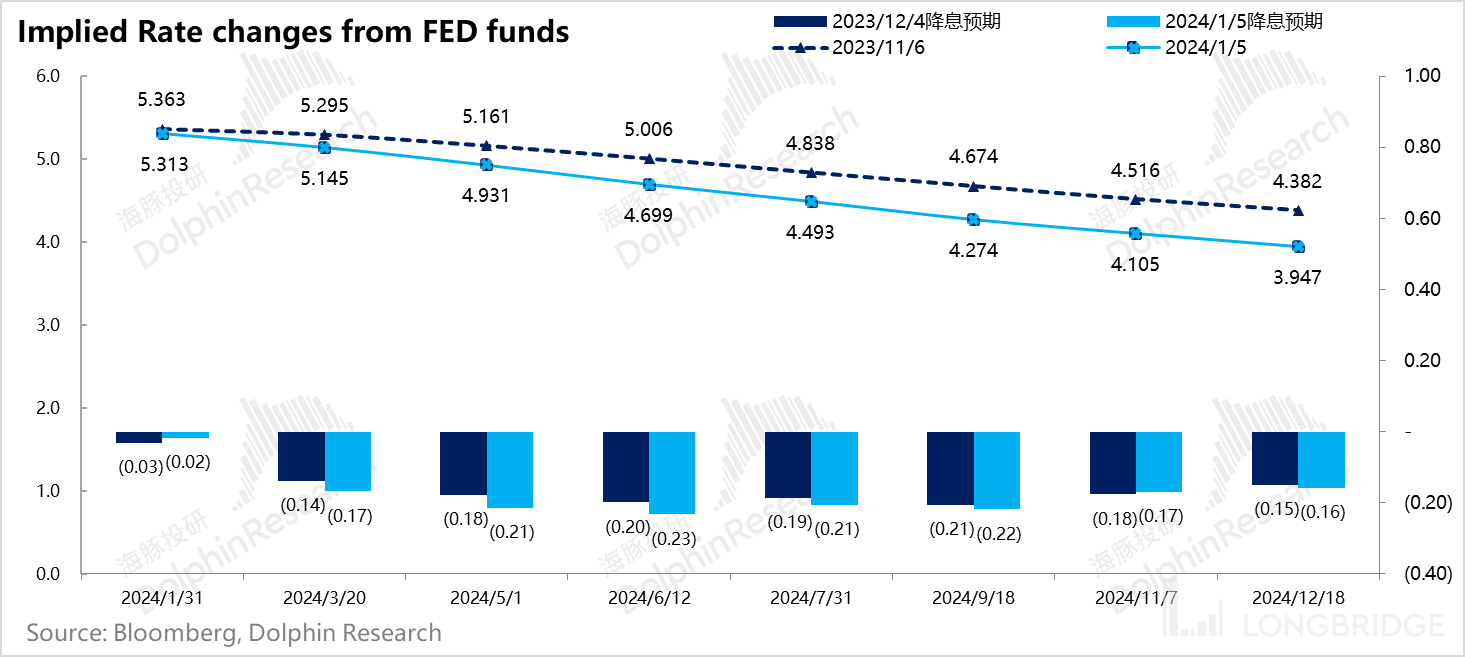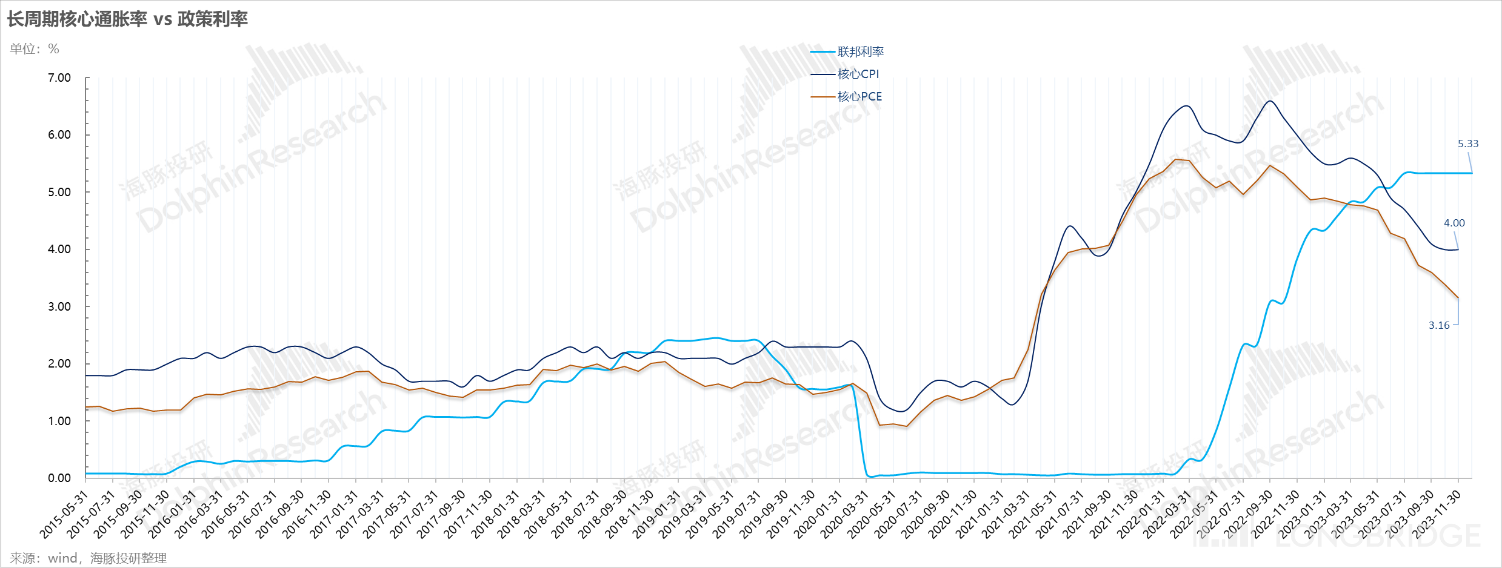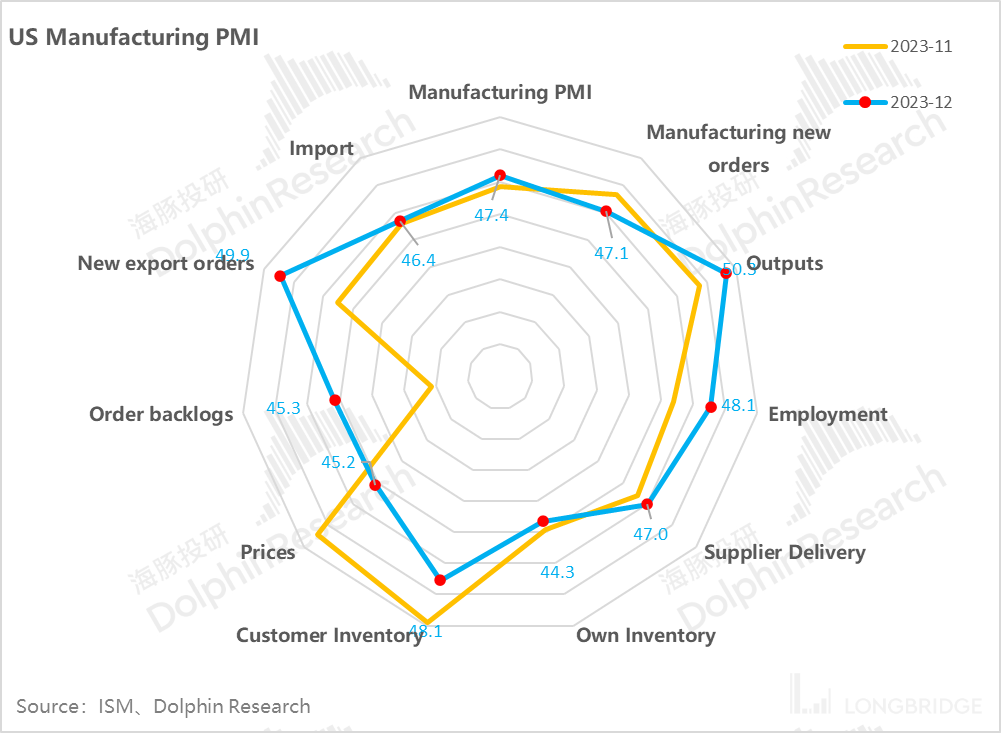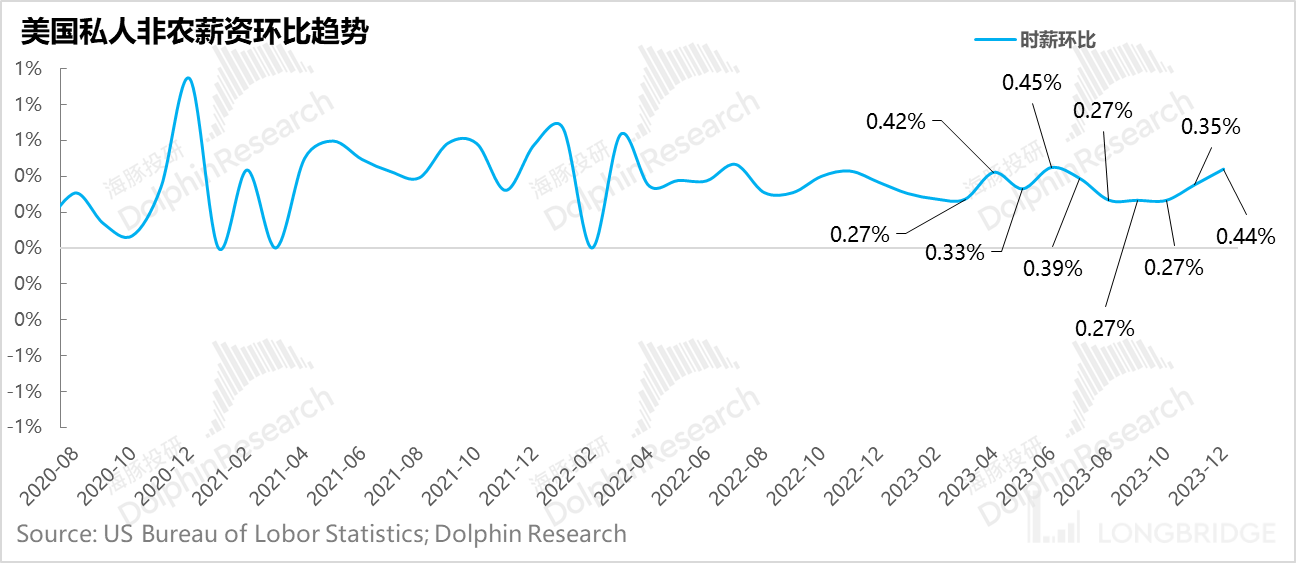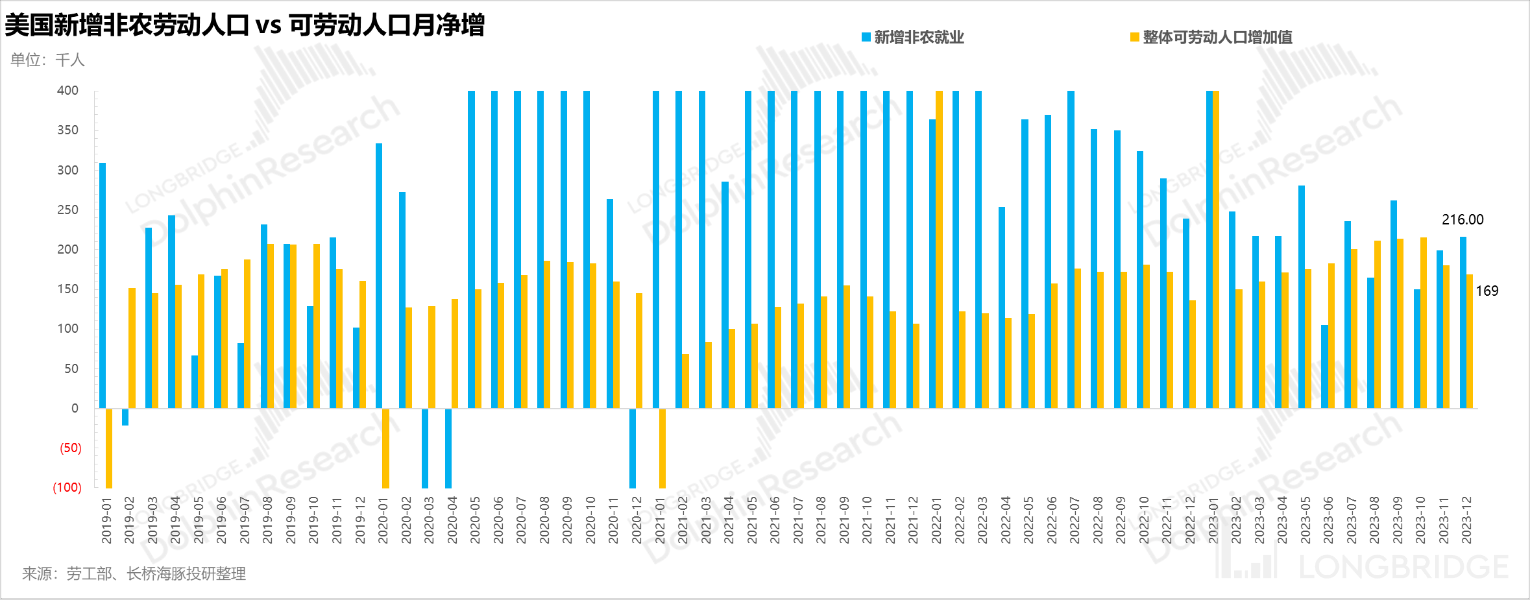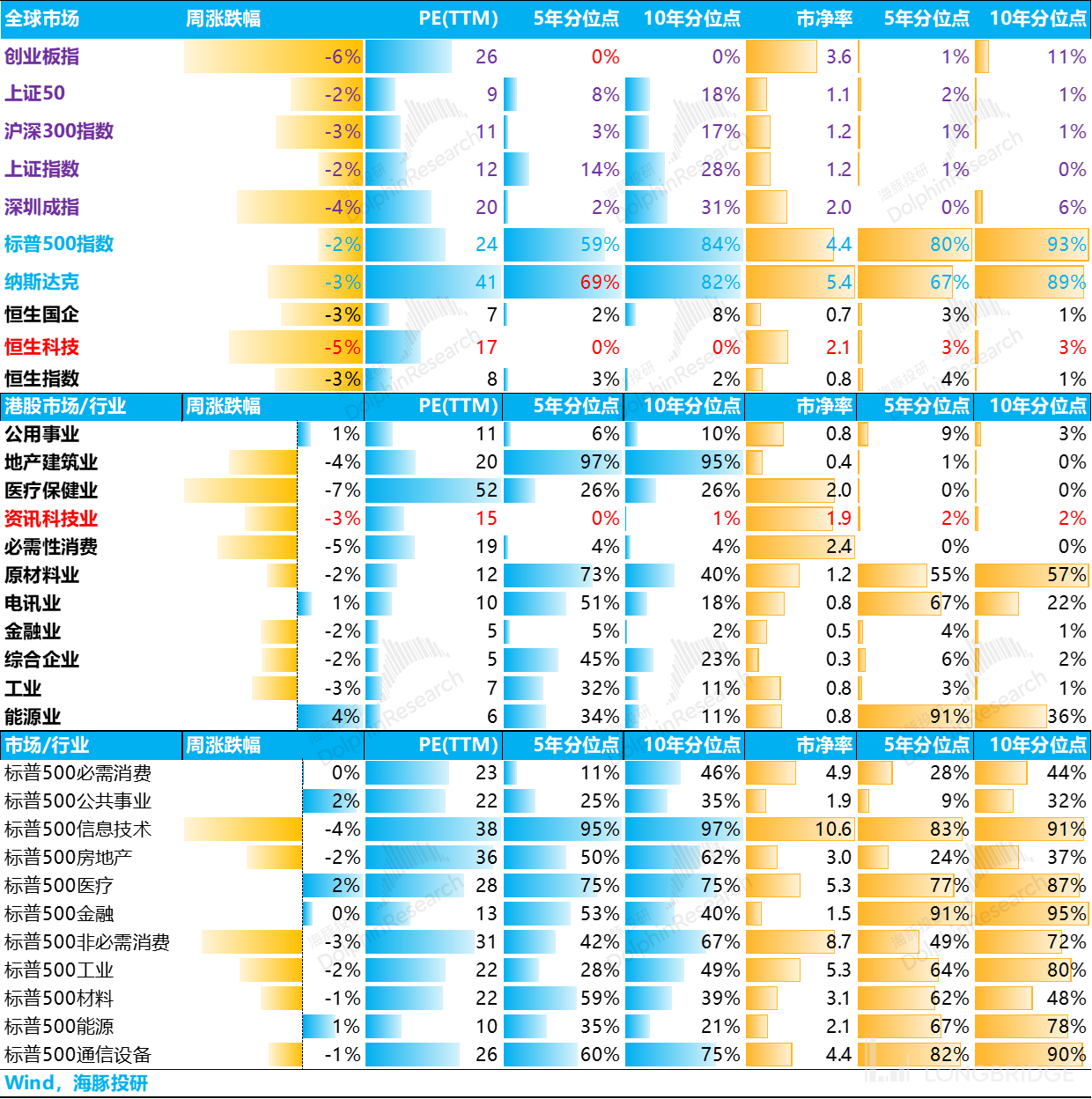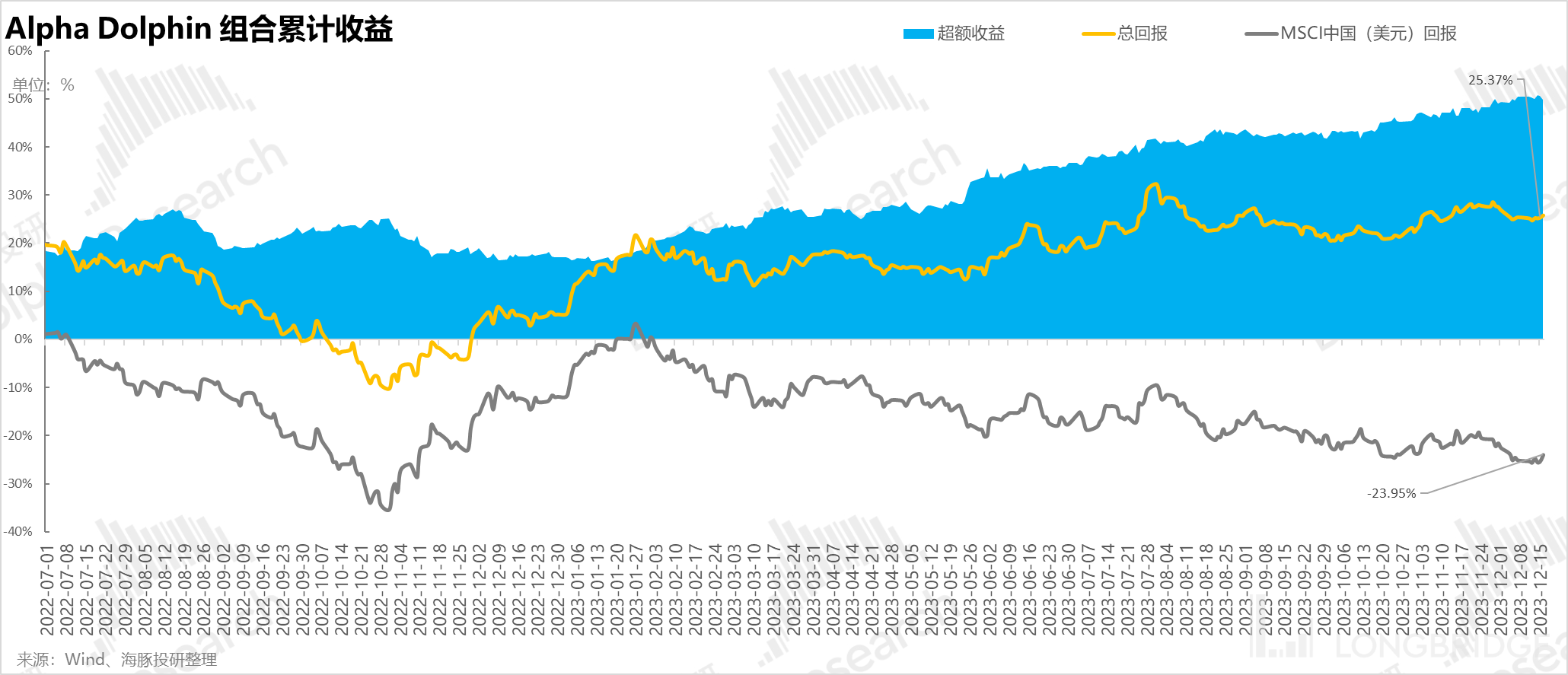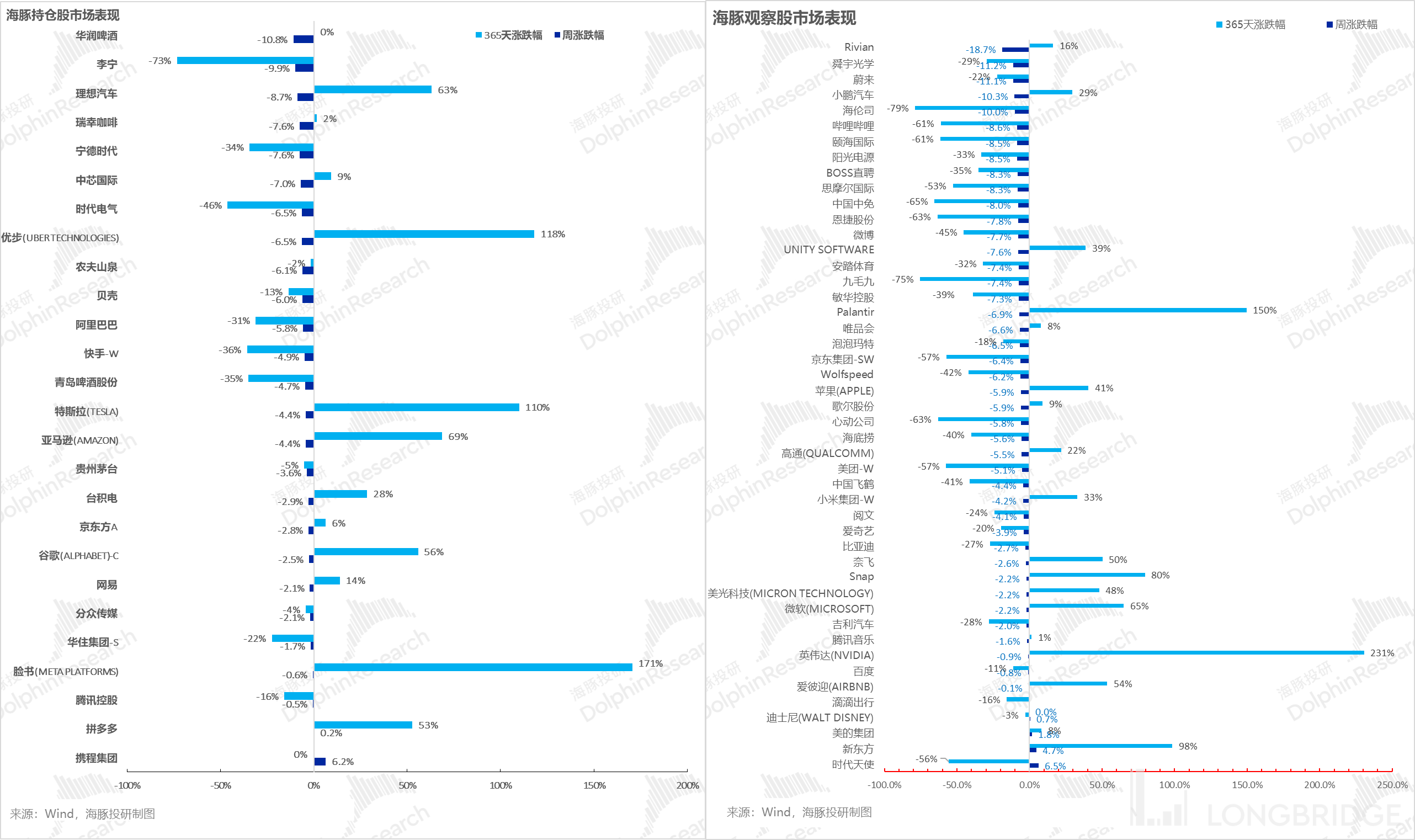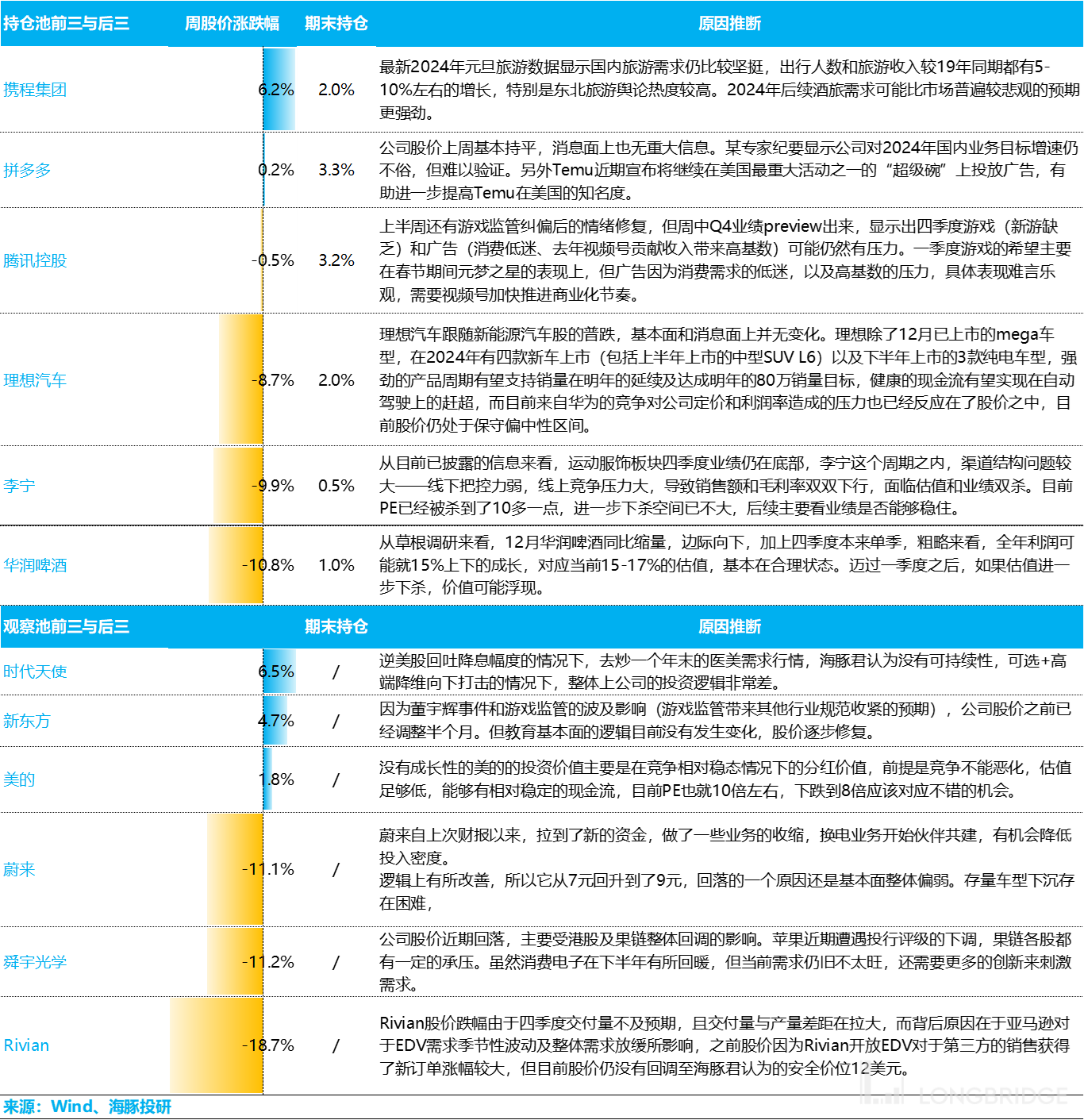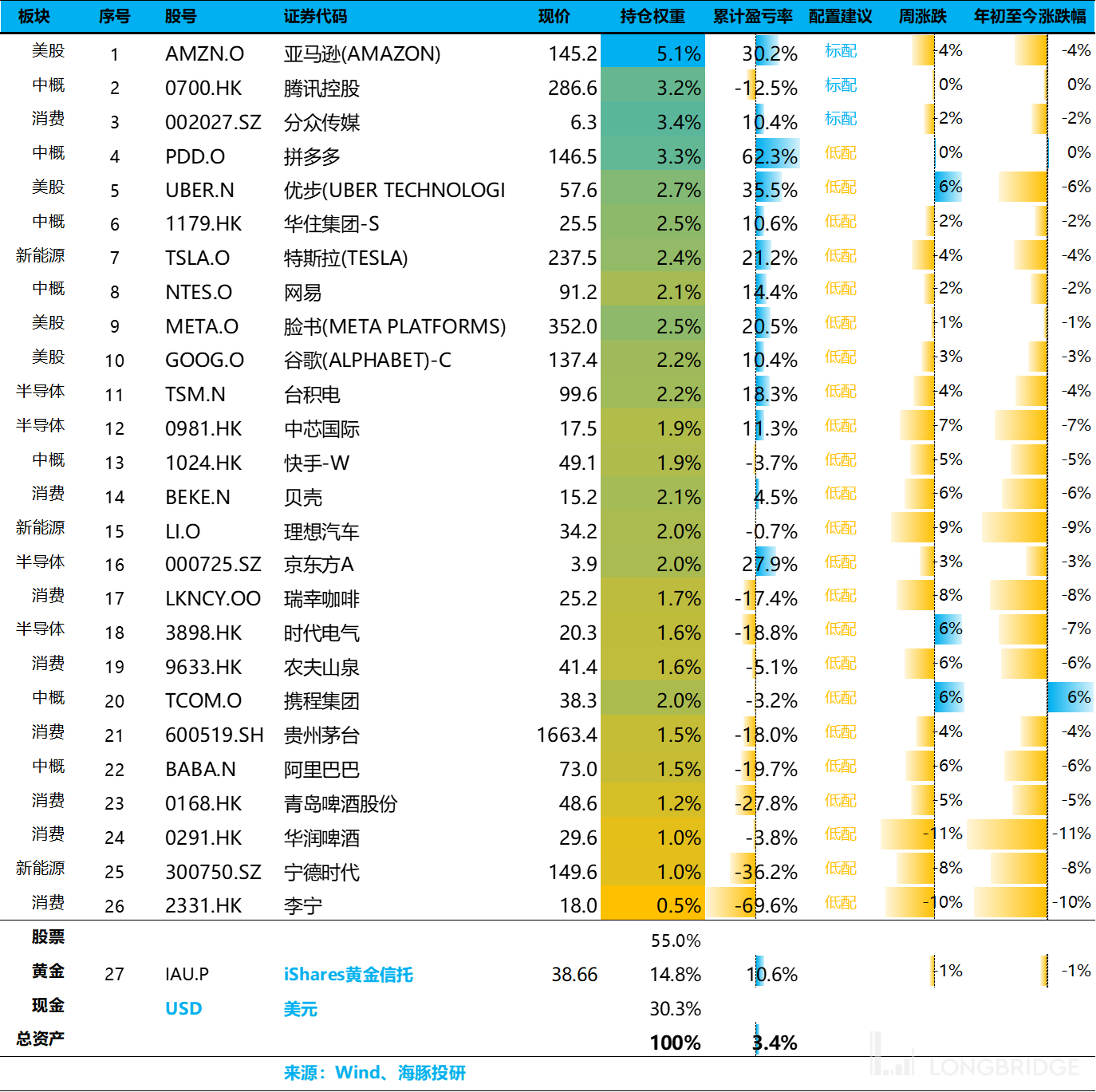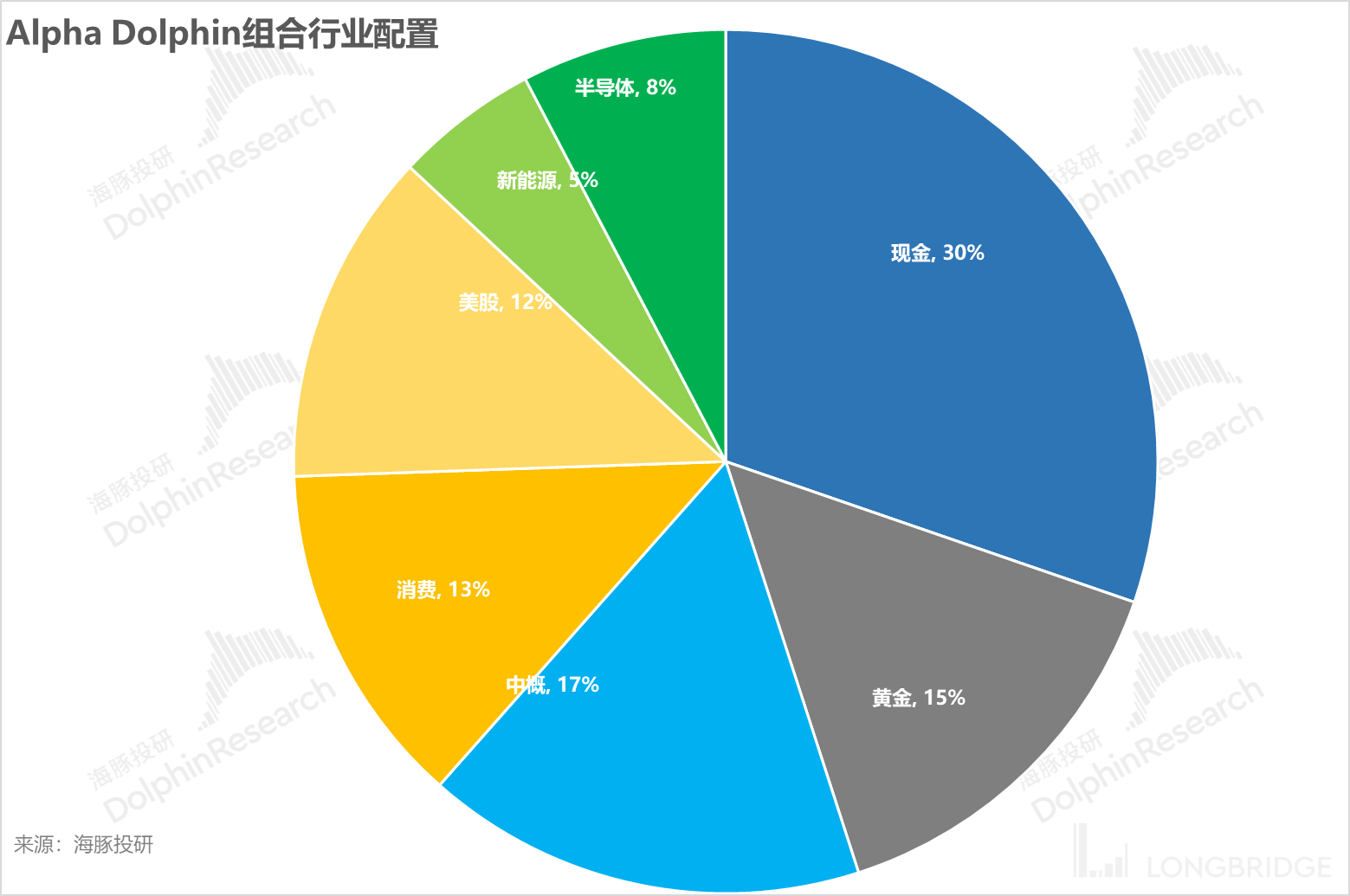
 Likes Received
Likes Received Posts
Posts2024 US: A strong economy and quick interest rate cuts? Wishful thinking to backfire

Hello everyone, here is Dolphin Research's summary of the core information on this week's portfolio strategy:
1).The perfect path of market trading encountered a macro data test last week. As a result, the return of the strike in the United States has strengthened the state of "employment and wage growth, but a shortage of job opportunities".
Under the atmosphere of buying during the Chinese New Year, offline retailers such as department stores and supermarkets are actively hiring, with an increase of over 200,000 new jobs and an hourly wage growth of over 0.4% compared to the previous month. The unemployment rate remains at only 3.7%. In this trend, it can be determined with a high probability that the US economy driven by domestic demand is in good shape.
2) However, in December, compared to November, the economy accelerated. Due to a stamp from the Federal Reserve, the market has priced in an additional 40-50 basis points of interest rate cuts. By the end of 2024, the US is expected to cut interest rates by 140-150 basis points, far exceeding the 75 basis points predicted by the FOMC.
Dolphin Research believes that the key issue here is the market's linear extrapolation based on historical experience versus the Federal Reserve's decision-making process influenced by fiscal financing. In the past, a prolonged period of interest rate cuts corresponded to a continuous decline in economic fundamentals and a monthly downward pace of interest rate cuts.
However, in Dolphin Research's view, the stamp from the Federal Reserve this time is more about financing through medium and long-term bonds next year to alleviate the high cost of new financing caused by the massive fiscal debt burden. It is difficult for the second type of interest rate cut driven by this reason to follow a linear downward trend like the first case.
3) Currently, the overall market still tends to accumulate: the valuation of US stocks is still relatively high, and the extent of the pullback is not enough, making this position still unattractive. In addition, Chinese concept stocks are entering the period of macro data releases and individual stock previews, and the overall information is more pessimistic.
However, from an overseas macro perspective, the US stock market will release CPI and PPI price data, and oil prices in December are still in a downward trend, indicating that price information may be biased towards the positive side. Taking all factors into consideration, Dolphin Research has not identified any good opportunities and needs to wait for the upcoming earnings season for cross-observation.
Here are the detailed contents:
After the surge in US stocks caused by the expectation of "interest rate cuts" stamped by the Federal Reserve, the United States entered a period of economic data verification last week. Overall, after the return of the strike, both forward-looking and lagging economic indicators showed signs of improvement.
In this situation, the previous market pricing of the "perfect economy" path - economic slowdown, followed by a direct linear interest rate cut with the door wide open, and interest rates declining all the way - seems to be too hasty.
I). Reality Check: Market Overeagerness
Taking November 6th, 2023, before the December 2023 Federal Reserve meeting, as an observation point and comparing it with the most recent trading day, January 5th, the implied interest rate cut by the Fed Funds futures exchange has been reduced by 140 basis points after last week, and the federal benchmark interest rate is expected to drop below 4% by the end of the year. This is more than 40 basis points deeper than the expected interest rate cut in early November last year.

Currently, the year-on-year growth rate of core CPI is about 4%, and the annualized growth rate of core CPI based on the current trend is around 3.5%.
At present, after the first half of the journey of inflation easing, during the second half of the journey from 4% to 2%, the labor supply market remains tight and wage growth continues to rise. With the backdrop of the ongoing "reindustrialization" in the United States, how long will it take? Currently, it is still unknown.
In the absence of a clear downward trend in core CPI, the market is running too far ahead by trading interest rate levels below 4% by the end of 2024.

II) Return of Strikes, Chinese New Year Rush, Employment Remains Strong
In particular, the macro data released last week for December showed a significant improvement compared to November:
a) Manufacturing PMI: After the return of strikes in various industries in the United States, the sub-indices of manufacturing output and employment in December began to improve, leading to an overall PMI index rebound to 47.4%.

b) Accelerated wage growth: Starting from November, the wages of American employees who returned from strikes have entered a phase of accelerated growth, with a month-on-month growth rate of 0.44% in December. With employment and wage increases, the job market is still "more jobs than job seekers". For an economy like the United States, which is driven by demand, the pressure on economic growth is not significant.

c) Chinese New Year rush, accelerated employment
The current non-farm payroll, 200,000 is a watershed. When labor supply is insufficient and the pool of available labor in the United States increases by 150,000 to 200,000 per month, there are still 200,000 new jobs added in the United States every month for job seekers.
Moreover, from a structural perspective, during this cycle, the private sector in non-farm employment has performed well due to lower corporate debt pressure and increased household income, while the debt-ridden government sector has a strong demand for hiring.
A simple calculation: During Trump's presidency from 2017 to 2021, the government sector lost a net of 4,000 jobs per month, while during Biden's presidency, the government sector added nearly 40,000 jobs per month. Even with the disruption caused by the pandemic, this difference is still astonishing.

There is a very interesting change in the employment situation in December:
Firstly, the number of new jobs in December was impressive, but the number of new jobs in November was revised down from nearly 200,000 to only 170,000. This downward revision of 30,000 in just one month seriously undermines the credibility of the labor department's data.
As for December itself, apart from the continued strength in the construction industry (especially in non-residential construction), and the healthcare industry, there was a surge in net hiring in the retail and apparel sectors. In the professional and business services sector, there was a clear net hiring trend in positions such as law, consulting, finance, technology, and management. Although temporary employment in blue-collar positions continued to decline, there was an increase in hiring in the catering industry.
Overall, even if we disregard the "whitewashing" of the labor department's data, there were no widespread layoffs in any industry from an employment perspective. In terms of overall employment, the construction industry remained strong, manufacturing was relatively stable, and the service industry, especially the healthcare sector, faced a persistent labor shortage during this period.
Summary:
When comparing points 1) and 2), it can be seen that the increase in December occurred while the economic fundamentals were strengthening, and the market trading defied the trend by raising expectations of a rate cut in 2024.
As for the Fed's early endorsement of a rate cut, Dolphin Research still believes that monetary policy has been hijacked by fiscal policy (see details in the Analysis Report). Giving rate cut expectations and timely rate cuts are beneficial for the issuance of long-term bonds in the second quarter, reducing financing costs and preventing the high interest rates from becoming a long-term burden on the US economy.
However, this is quite different from the logic of rate cuts based on deteriorating economic fundamentals in the past. In the past, the rate cut channel based on deteriorating fundamentals was basically linear and stable. That is, after the rate cut cycle that the market currently expects begins, the rate cuts gradually stabilize month by month. But in terms of the rate cut pace based on the consideration of the volume of fiscal medium and long-term bond issuance, Dolphin Research is skeptical about how much the rate will be cut by 2024.
3) Where is the market trading heading?
After overpricing the rate cut, the market is now giving back the excessive gains from before, which is not fundamentally different from the overall upward trend with fluctuations in 2023.
Dolphin Research still holds the same view as before: it will be difficult for the current valuation of US stocks to have good opportunities without a correction. However, in the absence of poor fundamentals, a correction caused solely by overpricing the rate cut and liquidity issues is not scary. As long as EPS remains intact, opportunities for good companies will emerge after the correction.
And perhaps the opportunities for excess returns in 2024 will come from finding good companies at good prices amidst the market volatility caused by fluctuations in the rate cut intensity and liquidity changes. From the perspective of current valuation percentile, the valuation of US stocks is still mediocre from an investment value perspective; and Chinese concept stocks are entering the period of macro data release + individual stock preview, with overall information leaning towards pessimism.
However, from an overseas macro perspective, there will be CPI and PPI price data released for US stocks, and oil prices in December are still in a downward trend, indicating that price information may lean towards being more positive. Taking everything into consideration, Dolphin Research has not seen any good opportunities and needs to wait for the upcoming earnings season for cross-observation.

IV) Portfolio Adjustment
No portfolio adjustment was made this week.
V) Portfolio Returns
In the week of January 5th, the Alpha Dolphin virtual portfolio had a downward return of 2.3%, underperforming the S&P 500 (-1.5%), but slightly stronger than the comparative indices - CSI 300 (-3%), Hang Seng Technology Index (-4.6%), and MSCI China (-2.7%).

Since the start of the portfolio testing until the end of last week, the absolute return of the portfolio was 25.4%, with an excess return of 50% compared to MSCI China. From the perspective of asset net value, Dolphin Research's initial virtual assets were $100 million, and it is currently $127 million.

VI) Individual Stock Profit and Loss Contribution
Last week was clearly another logic of pulling up valuations, with small stocks with fundamental flaws rallying, while previously rising large stocks had a delayed reaction. The stocks held in Dolphin Research's portfolio are mostly large-cap stocks with strong defensive attributes, and their response this time was relatively slow.
Last week, the market as a whole showed a state of killing valuations, with new energy stocks with growth potential and high sensitivity to interest rates, as well as consumer goods with relatively high valuations, all experiencing significant declines. The stocks that had smaller declines either had relatively strong fundamentals or had lower valuation requirements.

Regarding the companies with significant increases or declines in Dolphin Research's portfolio and watchlist last week, as well as the possible reasons, Dolphin Research's analysis is as follows:

VII) Portfolio Asset Distribution
This week, Alpha Dolphin's virtual portfolio did not make any adjustments and held a total of 26 stocks, including three standard stocks. The remaining equity assets were underweighted, with the rest being gold and US dollars.
As of last weekend, the asset allocation and equity asset holdings of Alpha Dolphin are as follows:


Risk Disclosure and Statement for this Article: Dolphin Research Disclaimer and General Disclosure
Please refer to the recent weekly reports from Dolphin Research:
"2023 American Suicide Rebirth"
"Fed's Sharp Turn, Can Powell Resist Yellen?"
"Year-end US Stocks: Small Gains Bring Joy, Big Gains Harm"
"Consumer Cooling Down, Is the US Fed Just Being Stubborn?"
"US Stocks Overdrawn Again, Finally the Opportunity for Chinese Stocks" Here are some articles for you to read:
Is the belief in the "never-setting sun" of US stocks back? Is it reliable this time?
Can high interest rates sustain consumer spending? Is the US really thriving or just hype?
In the second half of the Fed's tightening, stocks and bonds can't escape!
Did JD.com bring down Chinese concept stocks? The crux lies in the "three highs" of US stocks
Technology makes a comeback: Can US stocks replicate the brilliance of the first half of the year?
The Fed's "iron fist" keeps pounding, US stocks can't hold on anymore!
US stocks in the second half of the year are lackluster, Chinese concept stocks are waiting
Don't panic, the bottom for Chinese concept stocks may have already arrived
Enjoy your reading! "US Unemployment Rate Rises, Hope for Chinese Stocks"
"Inflation vs. Siphoning, Tough Times Ahead in the Second Half of the Year"
"US Government Spending Like Water? The Backlash Has Arrived"
"The 'Brotherhood' Behind NVIDIA and Tesla, Can It Continue in the Second Half of the Year?"
"Is There Redemption for Hong Kong Stocks?"
"Fitch Ratings is Just a 'Paper Tiger', Chinese Stocks Still Have Hope"
"After the Violent Rebound, Should Hong Kong Stocks Stay or Go?"
"With US Interest Rates Peaking, Can Hong Kong Stocks Be Saved?"
"Reality Strikes, How Far Can Chinese Stocks Rebound?"
- Look further, will the US interest rate hike exacerbate stagflation?
- Decoding the mystery of low savings in the US, is it sustainable?
- US housing market: Subprime sins, why is it resilient this time?
- Unraveling the recession: Where did it go after being mentioned, and can it come back?
- Does a short essay influence the market? Extreme pessimism followed by overcorrection is the key
- Is the US stock market still in a frenzy? Economic schizophrenia, beware of excessive joy leading to sorrow
- Purgatory vs. Revelry, what are the US and Hong Kong stock markets really trading?
- US stocks pulling valuations, Hong Kong stocks killing beta? Don't despair, a reversal is imminent
- Putting high interest rates in another bank? The probability of a soft landing is actually higher
- "ChatGPT vs Earnings Report: Can the giants' promotion support the US stock market?"
- "Is the promise of 'US recession, China recovery' going down the drain?"
- "The direction of US recession is set, it's just a minor setback, but a major blow."
- "US service consumption collapses, but the US stock market celebrates?"
- "Fed rate cut: Is it just a matter of time before a US version of Yu'EBao strikes?"
- "US stock market recession and rate cuts? Trading has already taken the lead."
- "Silicon Valley bank run crisis: Is the US recession about to arrive?"
- "After the US stock market gives back gains, the world can finally breathe a sigh of relief."
- "Is inflation really on the rise? Adversity brings opportunities."
- "Putting inflation aside, the signals within Alibaba and Baidu are more important"
- "Both Hong Kong and the US are weak, is the wolf coming again?"
- "High-frequency macro as a puppeteer, the US stock market is a puppet market"
- "A single bullish candle changes faith, is Tesla leading the US stock market comeback?"
- "How far is the US stock market 'danger' from the changing situation?"
- "The US stock market didn't have a red New Year, but the hammer of performance is close at hand?"
- "Digging into the root cause of the stagnant US stock market"
- "CPI has fallen back, why is the Fed still so stubborn?"
- "Is it really that easy to eliminate service inflation? Beware of market overcorrection"
- "Has the Hong Kong stock market finally found its backbone? Can the independent trend continue?"
- "The darkest moment before dawn: Is the focus on darkness or dawn?"
- "The US stock market 'strikes back' at reality, how much longer can emerging markets bounce?"
- A 100,000-word article: Valuation repair around the world? There is still a performance test
- China's asset violence rises, why is there a huge difference between China and the United States
- Amazon, Google, Microsoft's superstars falling? The "meteor shower" in the US stock market continues
- Behind the expectation of policy shift: Is the "strong dollar" GDP growth unreliable?
- The moment of testing "determination" has come again: Southbound takeover vs Northbound frenzy
- Slowing down rate hikes? The American dream is shattered once again
- Reacquaintance with a "iron-blooded" Federal Reserve
- A tragic second quarter: "Hawkish" voices are loud, collective difficulties
- Falling to the point of doubting life, is there still hope for a reversal?
- The Federal Reserve violently hammers inflation, but domestic consumption opportunities arise?
- The world has fallen again, the root cause of the US labor shortage
- The Federal Reserve becomes the number one bear, global markets collapse
- A bloodbath triggered by a rumor: risks are still present, looking for sugar in broken glass
- The US leans left, China leans right, and the cost-effectiveness of US assets is back
- Layoffs are too slow, the US still has to continue to decline
- US stocks: "Funeral celebrations" - recession is a good thing, the most aggressive interest rate hike is considered negative news
- The second half of interest rate hikes, the opening of "earnings thunderstorms"
- The epidemic is about to strike back, the US is about to decline, and funds are about to change their minds
- Current Chinese assets: "No news is good news" for US stocks
- Growth is already in a frenzy, but does it mean the US is definitely in decline?
- In 2023, will the US experience a recession or stagflation?
- US oil inflation, will China's new energy vehicles grow stronger? Analysis Report: The Federal Reserve's accelerated interest rate hike has brought opportunities for Chinese assets
Earnings Report: US stock inflation is skyrocketing again, how far can the rebound go?
Dolphin Research Portfolio is now up and running, keeping it down-to-earth
The copyright of this article belongs to the original author/organization.
The views expressed herein are solely those of the author and do not reflect the stance of the platform. The content is intended for investment reference purposes only and shall not be considered as investment advice. Please contact us if you have any questions or suggestions regarding the content services provided by the platform.

